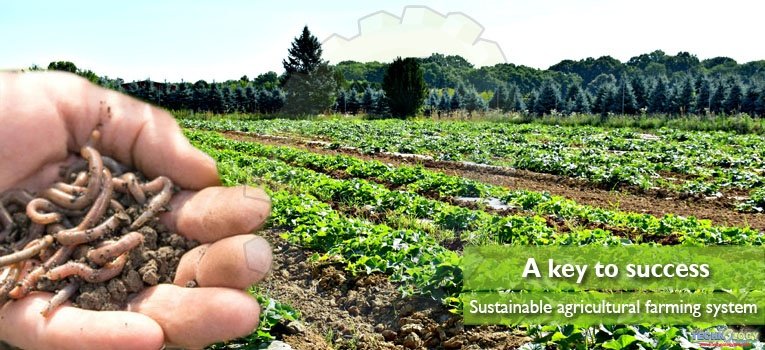Sustaining agriculture, traditional conservation minded methods combined with modern technology can reduce farmers dependence on possible dangerous chemicals. The rewards of the sustainable agricultural farming system are both environmental and financial.

Pakistan is an agricultural country. In our country, 48% of Pakistani population depends upon on agriculture. With the continuous use of traditional farming systems, might be the economic yield is greater due to the short-term benefits of expensive fertilizers and pesticides. But the excessive use of these chemicals leads to the deterioration of land thus making the future of our country unpredictable.
Instead of depending upon fertilizers, a sustainable farming system relies as much as possible on natural processes and renewable resources. As demand for food increase, there is a need to move towards a sustainable agricultural farming system for the conservation of natural resources.
The sustainable agricultural farming system refers to the production of food, fiber or the plant or animal products using farming techniques that protect the environment, public health, human communities, and animal welfare.
It is developed in response to concerns about impacts of agriculture such as soil degradation, depletion of non-renewable resources, food quality, decreasing number and increasing size of farms, environmental effects of chemicals, and inequity. Sustainable agriculture involves organic farming, ecological agriculture, alternative farming, biological agriculture, and regenerative agriculture.
The main target of this farming system is to achieve environmental health, economic profitability and social and economic equity. It helps farmers employ recycling methods in sustainable farming. For example, recycling in the sustainable agricultural farming system would be the crop waste or animal manure.
Strategies associated with sustainable agricultural farming
- Increased use of crop rotation
- Reducing stocking rate of animals
- Maintenance of crop residue cover on the soil surface
- Reduced use of synthetic fertilizers and pesticides
- Improved use of organic manures
- Increased diversity of crop
- Maximize use of natural resources
Effect of Crop rotation
All sustainable agricultural farming systems involve the crop rotation that is a planned succession of various crops growing on one field. The purpose is to provide better weed and insect control, less disease build up, more efficient nutrient cycling, and other benefits as compared to traditional farming practices. In crop rotation, there is an increase in yield from 10 to 15 percent higher than when they grow in monoculture. In most cases, we preserve monocultures only by adding large amounts of fertilizer and pesticide. It helps in reducing the soil erosion and enhancing soil fertility.
Use of Organic and green manures
Addition of crop residues, manures and other organic materials to the soil is another central feature of sustainable farming. Organic matter improves soil structure and increases the water-storage capacity of the soil. The better the tilth, the more easily the soil can be tilled and the easier it is for seedlings to emerge and for roots to extend downward. When the physical condition of the soil improves the soil is easily tilled. Water readily infiltrates soils with good tilth, thereby minimizing surface runoff and soil erosion. Organic materials also feed earthworms and soil microbes.
The main sources of plant nutrients in sustainable farming systems are animal and green manures. A green manure crop is a grass or legume that is plowed into the soil or surface mulched at the end of a growing season. The purpose is to enhance soil productivity and tilth. Green manures help to control weeds, insect pests, and soil erosion, while also providing forage for livestock.
Disease control with sustainable agriculture
Plant residues of cover crops, green manures, and other plants can decrease the population of parasitic nematodes and reduce the infection when applied to soil. Some plant residues release chemicals that are toxic to nematodes. Nematode species that have been controlled with un-composted plant residues include those in the main plant pathogenic genera: Meloidogyne, Pratylenchus, Globodera, and Heterodera. The plant residues that are not composted may also provide a substrate to sustain the growth of competitive soil Microflora and fauna.
Restrictive use of pesticides
Controlling insects, diseases, and weeds without chemicals is also a goal of sustainable strategies. Integrated Pest Management (IPM technique is beneficial to reduce the use of pesticides. It may involve disease-resistant crop varieties and biological controls. Farmers can also select tillage methods, planting times, crop rotations and plant-residue management practices to optimize the environment for beneficial insects that control pest species or to deprive pests of a habitat. We should have to use pesticides when the population of pests is more than the acceptable limit and it causes the loss in yield. Biological-control techniques are some of the best ways to control pests without pesticides.
A lasting impact of sustainable agriculture
Soil health is central to any sustainable farming system and it has physical, chemical and biological components. The sustainable farming system has an everlasting impact on overall soil health by improving soil condition. Because, we use organic manures, green manures, and compost that increase the Cation Exchange Capacity (CEC) of our soils. Which helps in the aggregation of soil particles, ultimately improving the soil physical properties.
The productivity of sustainable agriculture is long term. It had a better capacity for storing nutrients, higher water content, a larger microorganism population, and a greater polysaccharide content. Improving the quality of the soil improves the quality of water by reducing the turbidity of water. Improving the quality of soil improves the economic sustainability.
Conclusion
Agriculture is a fundamental component of the natural resources. It rests not only the quality of human life but also its very existence. If efforts to create a sustainable agriculture are successful then farmers will profit and society will benefit in many ways. More important, Pakistan will protect its natural resources and move closer toward attaining a sustainable agricultural farming society.
The useful criterion for guiding change in agriculture farming system, its characterization should be literal, system-oriented, quantitative, predictive, stochastic and diagnostic. These elements identify weaknesses in existing and proposed approaches, suggest directions for the future development of approaches.